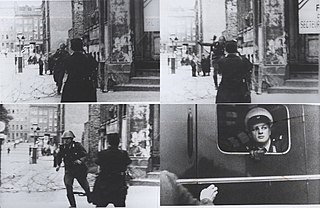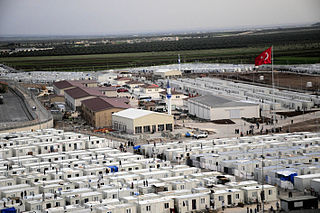Resettlement programmes
Since 1995 Annual Tripartite Consultations on Resettlement (ATCR) are held. The UNHCR, involved or interested governments as well as NGOs come together to discuss global and national resettlement strategies, cooperations and make agreements on resettlement. [36] In 2012 there were 26 third countries which run specific and ongoing resettlement programmes in co-operation with the UNHCR. [37] The largest programmes are run by the United States, Canada and Australia. A number of European countries run smaller schemes and in 2004 the United Kingdom established its own scheme, known as the Gateway Protection Programme [38] with an initial annual quota of 750. [39] The smallest is run by Japan which offers 30 resettlement places per year. [37]
Europe

In September 2009, the European Commission unveiled plans for new Joint EU Resettlement Programme. The scheme would involve EU member states deciding together each year which refugees should be given priority. Member states would receive €4,000 from the European Refugee Fund per refugee resettled. [40]
United States
The United States helped resettle roughly 2 million refugees between 1945 and 1979, when their refugee resettlement program was restructured. Refugees destined for the United States are screened by six different federal agencies. [41] The average time it takes from the referral to the arrival of a refugee is 18 to 24 months. [41] The United States has an Office of Refugee Resettlement (ORR) that aids the refugees in resettlement through programs that provide them with critical resources that help them become integrated members of the American society. [42]
In a recent exploratory study of approaches used in ORR Programs, they identified a number of key factors that contributes to successful employment: 1) pre- and post-employment services, 2) individualised goal-oriented approaches with each refugee, 3) culturally diverse staff, 4) refugees that are survivors with high levels of motivation, 5) clear message about the ORR's mission statement in all programs, and 6) proper coordination among refugee providers and between refugee and mainstream services at the system level. [43] The ORR has also identified a number of areas of improvement in these programs such as need for understanding of employment structure of the community by refugee service agencies, more focus on the difficult to employ, increased creativity in identifying job opportunities and overcoming barriers, creating more appropriate levels of subsidy and training for each position, more understanding of cultural issues that influence program design, etc.
The number of refugees resettled to the United States is statutorily limited by an annual ceiling that the President determines each fiscal year(FY). Since 1980, around 50,000 refugees resettled each fiscal year. [44] [45] This year (FY 2019) the number dropped from 45,000 to 30,000, the lowest it has been in history after the brief period after 9/11. [46] In September 2019, the Trump administration announced its intention to further reduce the refugee quota to 18,000 for the incoming fiscal year (FY 2020). [47]
As a result of the 1980 Refugee Act, the US State Department and federal refugee resettlement program formally acknowledges and coordinates with 11 "Voluntary Agencies" (VOLAGS), which are non-governmental organizations that assist the government in the resettlement process. [48] [49] These organizations assist the refugees with the day-to-day needs of the large transition into a completely new culture. The US State Department and Office of Refugee Resettlement offers grants for the purpose of providing for refugees' day-to-day needs, and many VOLAGS additionally draw from their own resources and volunteers. [50] Most of them have local offices, and caseworkers that provide individualized aid to each refugee's situation. They do rely on the sponsorship of individuals or groups, such as faith-based congregations or local organizations. The largest of the VOLAGS is the Migration and Refugee Services of the U.S. Catholic Conference. [49] Others include Church World Service, Episcopal Migration Ministries, the Ethiopian Community Development Council, the Hebrew Immigrant Aid Society, the International Rescue Committee, Lutheran Immigration and Refugee Service, the U.S. Committee for Refugees and Immigrants, and World Relief. [51]
There are a number of advantages to the strategy of using agencies other than the government to directly assist in resettlement. First of all, it has been estimated that for a federal or state bureaucracy to resettle refugees instead of the VOLAGS would double the overall cost. These agencies are often able to procure large quantities of donations and, more importantly, volunteers. According to one study, when the fact that resettlement workers often have to work nights, weekends, and overtime in order to meet the demands of the large cultural transition of new refugees is taken into account, the use of volunteers reduces the overall cost down to roughly a quarter. [48] VOLAGS are also more flexible and responsive than the government since they are smaller and rely on their own funds.
Studies have found that refugee settlements in the United States have no impact on terrorism or crime. [52]
Economic empowerment in the United States
Refugee resettlement in the U.S. emerged as a response to the violence brought on by World War II that displaced millions of people in Europe. Non-governmental groups partnered with the U.S. government to respond to this humanitarian crisis in the 1930s, playing vital roles in the future in resettlement of refugees. [31] In the next forty years, the U.S. was committed to expanding its focus to other continents as well, coordinating with Non-Governmental Organizations to help those most in need. [53] The Refugee Act of 1980 established political asylum in the United States, creating refugee resettlement programs to ease the transition to the refugees’ life in America. [31] One objective of the U.S. Refugee Act of 1980 was economic self-sufficiency. Efforts were made towards helping refugees find employment and cease dependence on federal/state aid. After the passage of the Personal Responsibility and Work Opportunity Reauthorization Act under President Clinton, poor families could receive support for five years provided they maintained a job search. [53] After this period, U.S. federal law prevented any further forms of cash assistance. [53] This affected legal immigrants/refugees as they struggled to learn English and find employment at the same time. These key events intertwined the relationship between federal/state governments and non-governmental organizations as they partnered to provide resources to refugees.
The refugee program in the US emphasizes the work-first approach. [29] The result of this approach is an increase in employment rates as refugees are provided with resources—English language lessons, resume building, interview skills, etc.—that prepare them for obtaining their first job in the U.S. The limits of this approach have been ignoring barriers to employment rates including mental and physical health problems, and unfamiliarity with work and social culture in their new environment. [30] This job-first focus does not take into account that refugees have limited time to adjust to their new environment. [29] Without acknowledging people’s concerns from a bottom-up perspective (a perspective that allows refugees themselves to make informed decisions and create change for themselves), the job-first focus approach cannot be as effective. The result is underemployment. Regardless of their qualifications, new refugees take low-level jobs as janitors, hotel maids and domestic workers. [54] Interviews with refugees often portray the shame members of the group experience, while on paper they are employed and ‘self-sufficient’. [54] The job-first approach may be effective in helping refugees find low-skilled jobs immediately, but it ignores the underemployment rate and their other essential needs. It encourages ceasing dependence on welfare. [55] Experts suggest that approaches must strengthen the workforce, allowing refugees to build essential skills towards further advancement in economy or education, which can be done by addressing other needs such as mental health, affordable housing, and going further than policies that determine the lowest wage needed for mere survival. [56]
A challenge for empowerment has been determining who is responsible for providing funds. Although the U.S. Department of State has provided funding over the years, empowerment programs have struggled as the number of refugees increased and unemployment rose within the country. [32] In communities in the US cities such as Tennessee, states and local governments experience unemployment and budget issues, and question the costs of resettlement especially regarding the use of resources to meet the housing, education, and health needs of refugees. [32] These governments have no choice but to put the responsibility into the hands of the private sector and refugees to sustain themselves. [55] The role of the government has become limited and they attempt to solve poverty in the cheapest manner possible, providing little public money, and without expanding the involvement of the government. [55] This not only affects the poor within the US but refugees who struggle to find jobs. Without appropriate funding, pressure is put on local welfare agencies, giving them discretion over who obtains resources. [54] Rationing has become a common practice found among workers at the front lines of service delivery who must balance client demand with limited resources. [54] Under these circumstances workers will routinely expend limited resources on select clients, while withholding them from others. Street-level studies have also found that workers routinely target resources at the clients who are most likely to succeed at the desired outcomes of the intervention. [54] Neutral legislation in practice varies across the nation since local offices have discretion over distribution of resources. [54]
South America
Around 1,100 refugees, mainly Colombians, were resettled within South America between 2005 and 2014 through the "Solidarity Resettlement Programme". However, as many refugees expected to be resettled to the US or Europe 22% of them left again, possibly returning to the country of first asylum or the country of origin. [57]
In 2011 the combined quota of Argentina, Brazil, Chile, Paraguay and Uruguay together was 230 resettlement places. [37]







